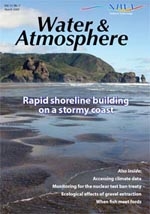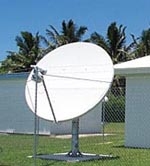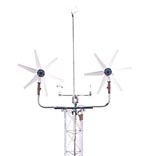PDF of this article (235 KB)

Science and technology have been applied to help protect the world from what may be one of the most significant threats to the environment. Jeremy Bulleid, Graham Elley, Bob Newland, Martin Gledhill, and Owen Kilgour describe the first stages of a Pacific monitoring network.
The Comprehensive Test Ban Treaty (CTBT), which at the time of publication has been signed by 175 countries including New Zealand, is seen as a major step towards the curtailment of nuclear-weapons production and eventual disarmament. However, the treaty can be effectively implemented only if there is a monitoring system in place to verify that weapons testing is not taking place and, if it does occur, to identify the violator.
NIWA’s Instrument Systems group has been working with the National Radiation Laboratory (NRL) to design, build, and install the first of the Pacific Network of radioactivity monitoring stations to monitor for nuclear weapons testing. The Pacific Network will form part of a global network that has been established under the CTBT. These monitoring stations are now located at Kaitaia (North Island of New Zealand), Rarotonga in the Cook Islands, the Chatham Islands, and Fiji.
Because nuclear weapons can be detonated in any environment, the monitoring system comprises four technologies:
- infrasound monitoring to provide real-time information on atmospheric explosions
- seismological monitoring for underground explosions
- hydroacoustic monitoring for underwater explosions
- radionuclide monitoring for atmospheric explosions and venting from underground explosions.
All monitoring stations transmit their data directly to an International Data Centre (IDC) in Vienna. There data are collated and analysed and reports and alerts are sent out. The IDC is linked over a secure data network to every monitoring station and to the National Data Centres in signatory countries.
Detecting radionuclides


Nuclear weapons inevitably produce fission-product radionuclides in particulate or gas form which are released into the atmosphere. Because the radionuclide ‘signatures’ from the detonation of nuclear weapons are unique and well understood, their detection is definitive proof that a nuclear explosion has taken place. However, a major problem with this form of detection is that it is passive, and relies on the movement of air masses to the detector site. This requires a network of detectors in order to ensure that stations intercept the air masses from a detonation at any location in a timely manner.
Once radionuclides are detected, meteorological ’back-tracking’ is used to determine source location through analysis of wind patterns in the preceding days and weeks. Meteorological monitoring is therefore also an integral part of radionuclide monitoring. Before the detector sites were installed, NIWA scientist Steve Reid analysed the coupling of winds between the upper and lower atmosphere to verify that the sites were suitable for monitoring material transported by global wind patterns.
The radioactive monitoring equipment has been installed and commissioned by NRL, and the meteorological backtracking instrumentation by Instrument Systems.
Detecting atmospheric shock waves
Any explosion in the atmosphere generates a shock wave that radiates in all directions and dissipates as it travels away from the source. Low frequency (infrasonic – below the range of human hearing) components of the shock wave may travel great distances through the atmosphere, and be detected in arrays of specially designed microphones capable of detecting pressure changes of less than 1 Pascal. Infrasonic shockwaves from a 1-kiloton explosion can be detected at a range of a few thousand kilometres, with detonation sites anywhere from ground level to altitudes of more than 100 km.
A typical infrasound detection station comprises an array of four to eight microphones, arranged to provide equal detection capability from all directions. The spacing between microphones can be up to 3 km. An array is used because it provides information on the direction of the signal source, so detection at two or more stations allows determination of the location of the explosion.
Unwanted infrasound sources can interfere with the detection process in the monitoring station. In particular, local wind can produce infrasonic disturbances large enough to mask the signals from a real nuclear event. On Chatham Island, the microphone arrays were strategically sited to take advantage of the natural shelter provided by surrounding trees and scrub, and a network of pipes was used to average out the wind noise to improve detection capability.
Challenges of a remote location
There have been many challenges in developing and installing these monitoring stations at the more remote sites. For example, where there was no mains or other power available, a hybrid power supply was designed especially to meet the needs of the monitoring equipment.
NIWA climate data for the Chatham Islands indicated that, given enough exposure, there should be adequate power available through wind generators supplemented by solar-power generation, though neither system would be adequate on its own. But, there was a problem. The infrasound equipment needed to be located in a relatively sheltered location but the wind-powered generator required greater exposure to the elements. The problem was solved by locating the power supplies away from the infrasound equipment in a more exposed location.
We first established the relationships between wind speed and direction at the airport met station and the power supply sites. Then we wrote a simple model, suitable for the most difficult site, to ensure the power supply would prevail over projected worst-case wind and solar conditions.
However, the need to locate the power supplies in these exposed locations raised the risk of possible equipment damage from lightning strikes. So we designed a lightning-protection system and implemented it at each site. This will give some measure of protection against direct strikes, as well as indirect strikes and high voltage differences that may be caused by large electric currents flowing through the ground during the lightning event (about 10 microseconds).
Added benefits
There are also natural sources of infrasound, such as storms, meteorites, earthquakes, and volcanoes. The aviation industry is interested to see whether the network of CTBT infrasound stations can provide rapid warnings of volcanic eruptions, which can be hazardous to aircraft.
In addition to achieving its primary aim of supporting the Comprehensive Test Ban Treaty, the verification programme provides opportunities for extensive international cooperation, both scientific and political. Once the full network of 321 stations is complete, it will provide an unparalleled source of scientific data to help increase our understanding of global environmental processes.
Useful link
Learn more about the CTBT at the website of the Preparatory Commission for the Comprehensive Nuclear Test Ban Treaty Organization: www.ctbto.org
The authors are all based in Christchurch. Jeremy Bulleid, Graham Elley, and Bob Newland work at NIWA in the Instrument Systems group. Martin Gledhill and Owen Kilgour are with the National Radiation Laboratory.
